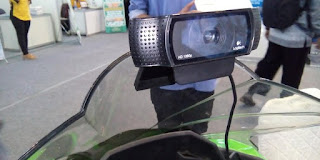Smart motorcycle for people with disabilities

Student of Faculty of Computer Science (Philkom) Universitas Brawijaya (UB) Malang created an intelligent motorcycle for people with disabilities. Motorcycle named Electric Mini Seater (EMS) was designed to help people with disabilities, who do not have both hands.
In plain view, EMS design is not much different from the motorcycle in general. It's just a three-wheeled motorcycle and seat equipped with a backrest.
The still prototype motorcycle is connected to the computer and the monitor screen. A mini computer is stored on the front of the motorcycle and connected to the monitor screen.
A monitor screen is placed in front of the driver, precisely in the usual part for the speedometer board. The monitor screen serves to monitor computer and travel processing.
A camera is placed aimed directly at the driver's eyes. The camera records the movement of the eye retina as well as the command input for the motorcycle.
"When the pupil of the eye moves to the right, the steering wheel will turn to the right, as if moving to the left, also turn to the left.Computer will process orders from the rider's eye position," said Abdurahman, one officer at UB IT Innovation Gathering (UB ITIG) 2016 in GOR Pertamina UB, Monday (16/10).
The prototype motorcycles are exhibited in UB IT Innovation Gathering (UB ITIG) 2016 at Pertamina GOR UB, Monday (16/10).
Motorcycle without a steering wheel or handlebar, because it is intended for the disabled who have no hands. The basic shape is a modification of motorcycle type matic sold in the market.
"It's still a prototype, the speed is still constant, we still prioritize the safety of the rider first," he said.
The team members of the inventor Electric Mini Seater include Fitri Utaminingrum, Muhammad Ali Fauzi, Yuita Arum Sari, Renaldi Primaswara and Sigit Adinugroho. They have been doing research for about six months.
But until now still not ready to be operated in public street. Progress is still about 60-70 percent of the ideal form. The accuracy of the given command detection, or detection of the pupils is still 83 percent.


like more
ReplyDelete